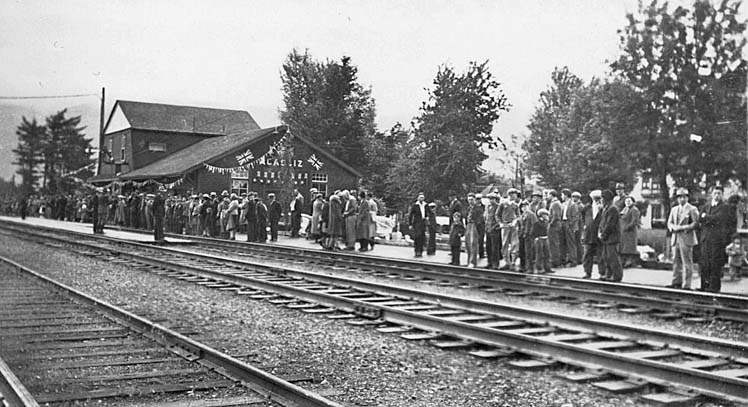
for the Second World War - 1943 Photographer unknown - Agassiz-Harrison Historical Society.
Train Station Can Tell
Agassiz British Columbia - Agassiz's Pioneer Avenue and Park have been abuzz with the filming of the Republic of Sarah over the past two
weeks.
Many of our businesses and organizations have been involved, including the Agassiz-Harrison Museum.
This is my first experience working with the film industry, and it has been a real treat for the anthropologist in me.
Not surprisingly, I have started thinking about all of the people (and not just the "famous" people, be they movie stars, authors, politicians, or
royalty) who have passed through the Agassiz Canadian Pacific Railway (CP) station building since 1893, over 125 years of agents, their families, visitors,
soldiers, passengers, and tourists.
Before the development of the highways and associated bridges, the railway was the main land-based connector between communities within the Fraser
Valley.
Trains travelled both east and west along the CP line, not just east as they do today.
People and valuable cargo, mainly milk from Agassiz, were transported in an efficient and timely manner.
Visitors and workers arrived in our community, greeted by awaiting friends, family, and employers.
While the fashion of the people and the vehicles waiting to transport these folks to their final destination have changed over time, the station building has
remained an important fixture in our community.

Photographer unknown - Agassiz-Harrison Historical Society.
I am enthralled with the image of the Agassiz CP station decorated for what appears to be a Dominion Day celebration, circa 1920.
This is the only image that I have come across in our archives in which our building was "dressed" for a special occasion.
(If you have other photographs that illustrate the use of the building in or for a community event we would love to see them.)
The Agassiz-Harrison Museum archives hold many images of our station throughout the 1940s.
Several people documented the hundreds of soldiers moving out of, and returning to, the Valley "doing their part" during WWII.
This decade also marked a boom period for our community with hops as one of the main crops in production.
Workers and their families travelled to Agassiz for the harvest each year.
This cycle came to an abrupt end, however, in May and June of 1948, when the hop yards were devastated by the Fraser River flood.
I am slowly gathering information about the construction activities that have influenced the building over time.
These include the addition of porches on the front and back, the removal of the brick chimneys (the only remnants we have are the "patched" wood
floors in the former station agent's living quarters on the second floor), the covering of the exterior with asphalt shingles, and the "addition" to
the back of the building which created our collection's storage room and the smaller gallery.
If you have images or information about these changes over the past 50 years please share them with us.
Our humble "working" station has seen thousands of passengers and visitors, some of whom were "famous," pass through its doors over the
past 125 years.
Most recently, these have included American actresses and directors Sarah Drew and Kirsten Nelson during the filming of the Republic of Sarah.
One of my favourite encounters thus far was an impromptu visit last fall with author, speaker, and teacher Lee Maracle.
Maracle, a member of the Sto:lo Nation who was appointed an Officer of the Order of Canada in 2018, visited our museum with her family, and chatted with me
about the importance of staying true to your roots, true to yourself.
It was one of the most inspiring 20 minutes of my life, and I continue to reflect on her words each day.
Who knows who will walk through our doors next.
I can't wait to find out!
Lindsay Foreman.
provisions in Section 29 of the Canadian
Copyright Modernization Act.

